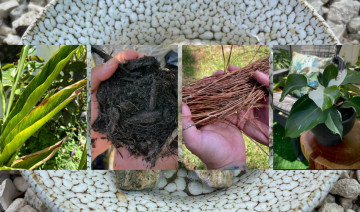
Heat Advisories! Protecting Your Plants From Heat Stress
Watering your plants deeply in the morning will help to combat heat stress during the day. Thorough watering also encourages the roots to grow downwards, plants with deep roots are much more resilient and capable of withstanding dry spells and extreme heat.

(Water your plants slowly and saturate the soil deeply)
If you water too lightly, it will evaporate too quickly and your plants will not have enough time for absorption causing leaf curling, burning, yellowing, complete leaf drop, and even dehydration, which all will lead to the death of the plant.
At the same time avoid overwatering while we are experiencing this extreme heat as it can lead to other issues such as root rot and fungal diseases, which can be just as destructive as heat stress. Excessive water can also limit airflow around the roots, causing your plants to drown and suffocate.

This is where your moisture meter comes in handy to measure the moisture levels of your soil.
Add some mulch to the garden.

(Wood/bark chip mulch)
It helps to add a 2-3” layer of organic mulch around your plants.
Organic mulch is anything that will break down, such as, straw, wood/bark chips, shredded leaves, and even pine needles.

(Pine straw mulch)
Mulch keeps the soil moist, and the temperature regulated for root health. Avoid using rock mulch around your plants as it compacts the soil and heats up in the sun. If you don’t want to use mulch, plant ground covers such as Purslane and Blue Days (Evolvulus). They are aesthetically pleasing and thrive in the sun and heat.

If your plants are in pots, move them to a shadier area in the afternoons. This helps them avoid direct sun during the hottest part of the day. Pots will dry out quicker than your in-ground plants and will need frequent watering.

(Umbrellas help add shade and are easy to move to around where needed)
Providing temporary shade like a patio umbrella, shade cloth or other fabric such as old bed sheets (light colored) pinned onto frames, hoops or poles to provide shade for plants in the extreme heat will help protect the leaves from getting scorched.

(Shallow bowls with pebbles and water help hydrate pollinators)
And don’t forget about our garden friends (and foes) they need water too!
Bees, butterflies, wasps, flies, and other pollinator insects all get thirsty, bunnies, lizards and snakes do too, especially during intense heat waves. Have a shallow water dish filled halfway with small pebbles or marbles so they have a place to hydrate and avoid drowning.
Keep birdbaths cleaned and filled with fresh water.

(Leaf curl and scorch)
It can take anywhere from a couple of days to a couple of months for stressed plants to recover. Recovery time depends on the amount of damage that the heat caused to the plant. If a stressed plant is completely neglected during a heatwave, it can take several months or even be impossible to revive it. Make sure you keep a close eye on your garden during extreme conditions, providing protection when you can.
If you have questions or concerns about your garden, come see our plant yard associates at either store location.
